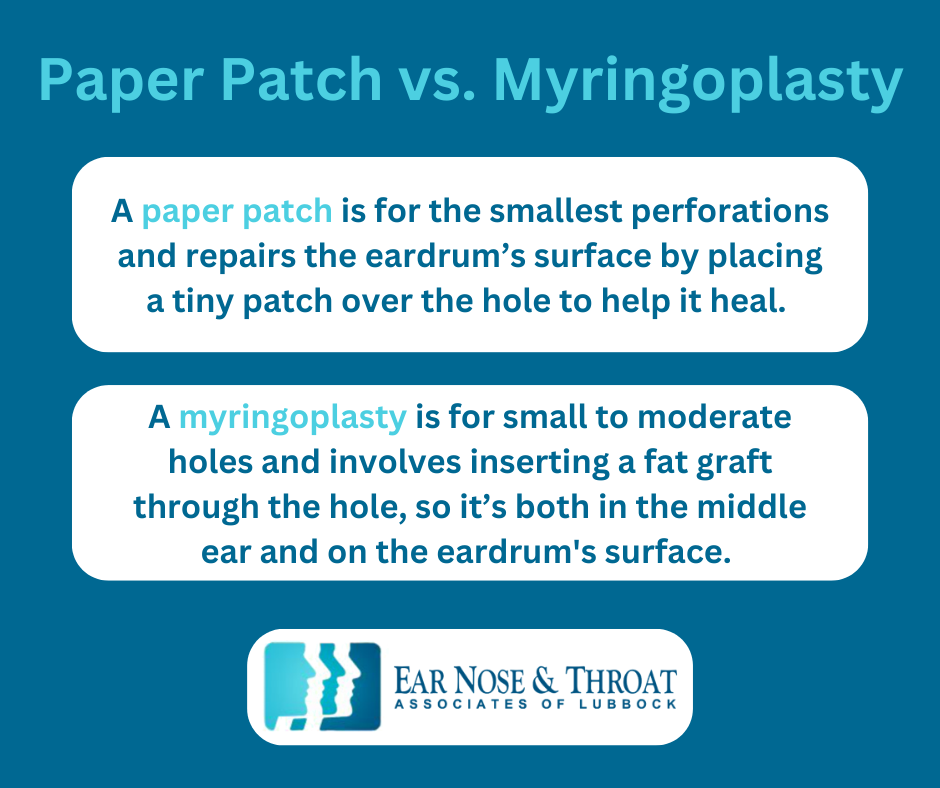Tympanoplasty vs. Myringoplasty vs. TM Patch: Differences Explained

In many cases, a perforated eardrum will heal on its own. But if yours doesn’t, you may need surgery to repair the damage to protect your middle ear and improve your hearing.
A tympanoplasty, myringoplasty, and TM patch (also called a paper patch) are all effective methods for repairing a hole in the eardrum. Which one is best for you depends on the size of the hole, your age, and your doctor’s recommendations.
To help you move forward with your treatment, we’ll compare a paper patch vs. a myringoplasty vs. a tympanoplasty so you can fully understand each procedure.
Why Is It Important to Treat Tympanic Membrane Perforations?
A tympanic membrane perforation is a medical term for a hole in the eardrum. These can result from severe or repeated ear infections or an injury, such as getting hit in the ear or pushing an object into your ear, like a Q-tip.
Your eardrum separates your outer ear from your middle ear, and it’s very important to maintain this divide.
As soundwaves hit your eardrum, the membrane sends vibrations through the little bones of your middle ear on to your inner ear and brain, where they’re interpreted as sound. A hole in your eardrum, especially a large hole, interferes with these vibrations.
Additionally, the eardrum protects your middle ear from water, bacteria, and debris that could otherwise get in and cause infection. Repairing a lingering hole restores this important protection.
The three main procedures an ENT may use to repair a hole in your eardrum are a tympanoplasty, myringoplasty, and a TM patch.
What Is a Tympanoplasty?
A tympanoplasty is a surgery to repair a large hole in your eardrum, typically caused by chronic infections or trauma.
During the operation, we enter through your ear canal or make a small incision behind your ear to lift the eardrum and access your middle ear. Once inside, we place a tissue graft underneath your eardrum to repair the hole from the inside.
A tympanoplasty is the most major of the three types of eardrum surgeries listed in this post. It takes about two to three hours to complete, and we prefer to wait until patients are at least eight years old before using it as a treatment option.
What Is a Myringoplasty?
We use a myringoplasty to repair smaller holes in the eardrum, also caused by chronic infections or trauma to the ear.
This simple operation involves repairing the surface of your eardrum instead of the inner ear. During the procedure, we go in through the ear canal and use a tiny piece of earlobe fat to plug the hole. As the hole heals over time, the fat is incorporated into the eardrum.
The entire surgery takes 10–30 minutes and is well-tolerated, even by children as young as one or two years old.
What Is a TM Patch or Paper Patch?
Like a myringoplasty, a TM patch or paper patch is a simple ear surgery that takes 10–30 minutes to complete. This procedure works best on the smallest of eardrum perforations.
During the operation, we enter through the ear canal to carefully roughen the edge of the eardrum perforation. We then place a small paper patch or Medtronic EpiDisc containing growth factors over the hole to enhance the healing process.

Paper Patch vs. Myringoplasty: What’s the Difference?
When comparing a paper patch vs. a myringoplasty, it’s easy to get lost in the technical details, and it’s not always clear what the difference is. Although they are similar procedures, there’s one main difference:
- A paper patch is for the smallest perforations and repairs the eardrum’s surface by placing a tiny patch over the hole to help it heal.
- A myringoplasty is for small to moderate holes and involves inserting a fat graft through the hole, so it’s both in the middle ear and on the eardrum’s surface.
How to Decide Which Procedure Is Right for You
It’s always best to see an ENT for a personalized recommendation, but here’s the bottom line:
- If the perforation is small, we’ll most likely recommend a myringoplasty or paper patch, especially if the patient is a child. Both procedures will encourage the hole to heal quickly and can be done when a child is young instead of waiting until they’re old enough to have more major ear surgery.
- If the perforation is large, a myringoplasty may still work to repair it. If that’s the case, we’ll recommend a myringoplasty over a tympanoplasty so you don’t have to endure a major surgery. A paper patch is exclusively for smaller perforations, so it’s not an option in this case.
Even a small hole in your eardrum can enlarge and cause more issues down the road. We prefer to catch the problem early so we can repair it with a simple myringoplasty or TM patch and avoid the need for more major middle ear surgery in the future.
All three ear surgeries mentioned above are safe ways to repair a perforated eardrum, but we may recommend one over the others depending on your situation.
Dr. Scolaro is a board-certified Otolaryngologist servicing the South Plains area. He has been practicing in Lubbock since 1990 and has earned a reputation as a skilled and experienced surgeon. He currently serves as the Medical Director for Covenant High Plains Surgery Center campuses, is a member of Covenant Health Partners and is an adjunct faculty professor for Texas Tech University Health Sciences Center School of Medicine. Learn more about Dr. Scolaro.
Categories:








